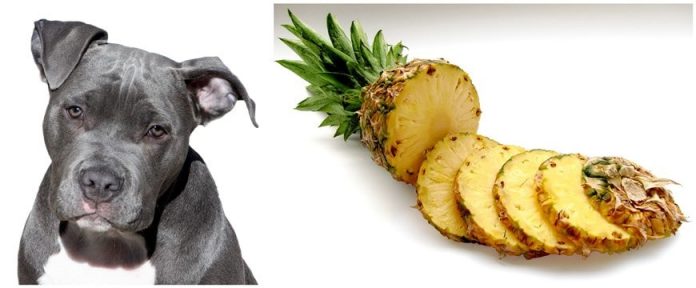Pineapple is one of the most versatile fruits you can ever find. You can eat it as it is, put it on skewers, on pizza, on your dessert, or on a baked treat. There is a lot you can do with pineapple, not to mention that it is also festive, refreshing, and most importantly, bursting with nutrients!
If you have a dog who loves fruits, you must be wondering if pineapple would be a safe treat for him. Or did he just get into pineapples and you are worried if it will cause any ill effects? Check out this post before sharing the goodness of pineapples with your furry little friend.
Are Pineapples Safe for Dogs?
Yes, they are! So, go ahead and share a few bite-sized pieces with your pooch. If your dog wants to get a taste of pineapple, you can give him a thin slice to start with. If your pet has never eaten pineapple before, it is best to offer it in small amounts.
According to the American Kennel Club, pineapples are safe for our doggies in moderate amounts. Just make sure to give your dog the fresh and raw variety because the canned ones are drenched in sugary syrup.
A slice of raw pineapple that is ¾-inch thick should be enough for dogs. This is equivalent to 84 grams, which is less than the usual serving amount for humans. This quantity already contains 8 grams of sugar, so giving your pet a few more slices would mean overconsumption of sugar.
Fruit sugar or natural sugar is not necessarily bad for our health. In fact, it’s a much better option compared to snacks with added sugar, including candies and cakes. Just a quick reminder, canines can also suffer from high blood sugar so be mindful of the amount of sugar you are feeding your dog, even if it’s fruit sugar.
Moreover, the canned variety does not containall the nutrients that a fresh pineapple does. Bromelain, which is the protein-digesting enzyme found in pineapples, is not present in canned pineapples as it gets destroyed during the canning process. In order for you or for Fido to reap the benefits of this fruit, stick to the fresh variety.
Aside from canned pineapple, avoid giving your pet dehydrated or dried pineapples. Like with the canned variety, many of the nutrients are already taken away from the fruit as it is exposed to heat. These types may still offer some of the nutritional benefits you can find in the fresh ones but we cannot deny that they may already contain certain amounts of calories and sugar.
Can Dogs Drink Pineapple Juice?
Yes, dogs can have some pineapple juice on occasion. In their pure form, fruit juicesare okay for dogs in moderate amounts. If you’re planning to offer pineapple juice to your pet, make sure it is free of sugar and additives that could make him sick. Also ensure Fido gets access to fresh and clean water after giving him fruit juice.
Important Reminder for Dog Owners
While pineapple is relatively safe for doggies, it can still cause stomach upsets, especially if your pet has never eaten it before. Anything unusualnormally causes vomiting and diarrhea in canines. In the event that these symptoms occurred after your dog ate pineapple, better not give it anymore.
If your pet threw up or had loose stools after snacking on pineapple, give his stomach a rest before offering anything again. Remember that dogs react differently to certain foods. There are a lot of fruits out there that are just as nutrient-dense and as delicious as pineapples such as apple, carrots, and bananas!
Like what we always advise, let your vet know if you are planning to tweak your dog’s diet or if you are thinking of giving him more raw food. Some pets who are used to eating commercial dog food may not find pineapple palatable. Again, dogs are different. Some are just too picky and won’t taste fruits while some enjoy their sweetness.
Benefits of Pineapples to Dogs
A slice of pineapple boasts roughly 180 milligrams of potassium. It has calcium, magnesium, and Vitamins A, C, and B-6. Apart from the many vitamins and minerals you can find in pineapple, the fruit also has dietary fiber. The bonus part is that it does not contain fat and cholesterol, so it’s a wholesome treat for dogs with weight issues or are suffering from high cholesterol. Here are a few more reasons why you should be offering some pineapple to your pet:
- The Bromelain in pineapples is a natural antihistamine. These enzymes can digest histamine levels and it is why it’s often paired with Quercetin to help support the immune system when allergens are present.
- It is helpful in treating canine injuries. Several studies already proved that Bromelain can significantly lessen bruising and swelling. If your dog is taking too long to heal or is suffering from a traumatic injury, your vet might suggest including Bromelain enzymes as part of the therapy.
- It can be used to help a dog with coprophagia. If your dog has a bad habit of eating his own poop, he must be suffering from coprophagia, a condition often caused by enzyme deficiency. Veterinarians usually recommend feeding dogs pineapples as it contains Bromelain. This enzyme can help break down the proteins inside your dog’s body.
- It can boost Fido’s immune system. Pineapples are packed with Vitamin C, which is needed for Fido’s overall health. This vitamin strengthens the activity of white blood cells in the body, therefore protecting your pet from diseases and infections.
- It can aid digestion. Our pets’ digestive systems are designed to break down animal fat. Still, they need some fibers from veggies and fruits for prebiotics. This plays a role in making sure your pet has a healthy gut.
- It can help canines with rheumatoid arthritis. Bromelain reduces the pain and swelling associated with arthritis, a condition that can cause extreme discomfort in dogs. Bromelain supplementation is commonly recommended for dogs with arthritis as it can help in making them feel at ease.
- It’s good for oral health. Pineapples have alkalizing properties, which prevents acidity that causes tooth decay. The Bromelain in pineapples can also reduce inflammation in dogs with tooth and gum infections.
Pineapple Recipes for Dogs
This tropical fruit can be used in a variety of dog treats. Take a look at our top 3 chosen pineapple recipes for doggies:
Pineapple with Tangerine Cookies
This recipe uses dried tangerine, although you can also use any dried fruit for your dog. Your best bets are dried apricots, pears, and prunes. Here’s how to incorporate the dried fruit to your pet’s treat:
- In a mixing bowl, mix 2 tablespoons of pulverized flax seed with four tablespoons of warm water. Set aside.
- Make your dough out of four cups of oats with the help of a food processor. Continue pulsing until you get a fine texture. Transfer to another bowl.
- Back in the food processor, combine a cup of crushed pineapple, 2 tablespoons of melted coconut oil, and the flax seed you set aside earlier.
- Add the flour gradually to create your dough.
- Form a ball using the dough then flatten it out to easily sprinkle half a cup of the dried tangerine.
- Cut the dough using any cookie cutter of your choice.
- Transfer the dough in a pan lined with parchment paper.
- Bake in a preheated oven at 350°F for 20 minutes or more if your pet prefers crunchy treats.
Tropical Pineapple Coconut Dog Treats
Like pineapples, coconut offers a myriad of health benefits to dogs. It is best known for its antibacterial and antifungal properties and that is why it’s often used for treating dog itching and oral problems. Thinking of incorporating coconut into Fido’s snacks? Here’s a wholesome way to do so:
- Make a puree out of a cup of fresh pineapples with the help of a food processor or a blender. Set aside.
- In a mixing bowl, mix your pureed pineapple with to2 tablespoons of coconut oil.
- Crack in a large egg and whisk until you get a smooth consistency.
- Add 3 cups of pulverized oat flour to the mixture.
- Transfer the dough on a floured surface then roll it out to around 1/4-inch thick.
- Cut using any shape of cookie cutter.
- Place the dough on cookie sheets lined with parchment paper.
- Bake in a preheated oven at 350°F for 20 minutes.
Pineapple Frozen Dog Treat
This three-ingredient frozen dessert is the perfect accompaniment during hot weather. This refreshment will be a nice reward for your pet after a long walk! Here’s how to do this easy-peasy treat for doggies:
- Slice half of a pineapple and one mango in small pieces.
- Put the sliced fruits in a blender.
- Add in one cup of organic coconut milk.
- Pulse until the mixture is smooth.
- Pour the mixture into ice cube trays and put in the freezer for around four hours.
Risks in Feeding Pineapples to Dogs
Pineapples are loaded with fiber. A 100-gram serving contains around 1.4 grams of fiber. If your dog is already on high-fiber dog food, it is not necessary to add more fibrous foods into his diet. While dogs need this nutrient for a healthy gut, too much of it can lead to diarrhea.
Another concern with pineapple is its core which can be too tough and is large enough to cause intestinal obstruction. Properly dispose of the core, the skin, as well as the leaves. This is very important especially if your pet has a strange habit of raiding the trash and eating table scraps. When ingested, these parts of the pineapple could get lodged in Fido’s digestive tract.
How to Select Ripe Pineapples for Your Pet
When choosing pineapples for your dog, go for the ripe ones because the unripe ones can taste unpleasant. Furthermore, reports suggest that eating unripe pineapples can be bad for the health because they can be toxic. So to be sure, here are the indications that the pineapples you are going to give your pet are ripe and suitable for eating:
- No signs of mold in the creases – when it comes to the appearance of pineapples, it is not necessary to look at the color as the basis of its readiness. Most pineapples are yellow when ripe but there is a variety that stays green even if the fruit is already ready for eating. So, just check the creases and see if there is any mold. If there are too many brown wrinkles then the fruit is most likely not ideal for eating.
- Leaves are not falling out easily – if you touched the leaves and it looked like they are not resisting a bit, this could be a sign that your pineapple is no longer good for consumption.
- It has a sweet and inviting fragrance – a ripe pineapple should smell just like its juice counterpart. It should smell sweet; otherwise it may have been harvested earlier than it was supposed to be. To know if it smells sweet enough, smell the bottom of the pineapple, not the crown.
The Bottom Line
You can share some pineapple to Fido from time to time, as this fruit is not toxic to dogs. In choosing pineapples for your pet, select the fresh ones over the canned variety. Avoid dried pineapples as they may have lots of sugar that are not healthy for dogs. Fruit juice, on the other hand, is fine for dogs on occasion so you can give some pineapple juice to your pet as well.






















